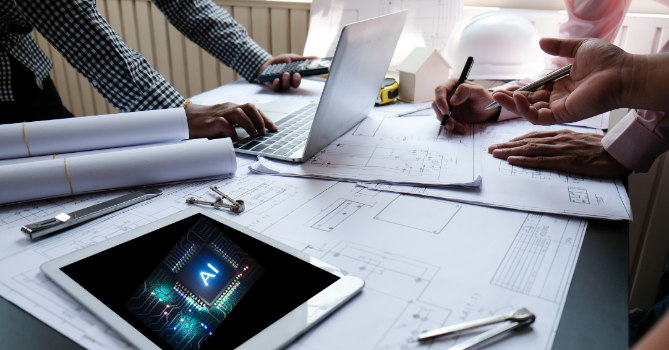.png)
How AI in Construction Estimating Increases Profitability
Introduction
Construction estimating has come a long way. In the past, estimators relied heavily on manual processes. This meant lots of paperwork, long hours, and room for human error. These estimates often lacked precision, which led to budget overruns and project delays.
Today, technology is changing all of that. Artificial intelligence (AI) is now part of the construction industry. AI tools help estimators create faster and more accurate cost predictions. By analyzing data and learning from past projects, AI reduces errors and saves time. The need for accurate estimates has never been more important. Clients expect faster results and tighter budgets. AI allows construction companies to meet these demands. It streamlines the process and gives estimators more confidence in their numbers.
In this blog, we will explore how AI can boost profitability by improving the estimating process. With AI, you can reduce costs, win more bids, and ensure your projects stay on budget.
What is AI in Construction Estimating?
AI in construction estimating refers to using artificial intelligence to predict costs more accurately. It analyzes large amounts of data, like project plans, material costs, and past estimates. AI tools can spot patterns and make predictions based on that data.

For example, AI can work with Building Information Modeling (BIM) systems to pull in real-time project details. It then uses this information to give more precise cost estimates. This saves time and reduces human errors. With AI, estimators can rely on data-driven insights rather than gut feelings. The result is faster, more accurate estimates that help keep projects on track and within budget. It’s a game-changer for the construction industry.
Key Benefits of AI-Powered Estimation
AI-powered estimation offers several clear benefits for the construction industry. First, it significantly increases accuracy. Traditional estimates often rely on human judgment, which can lead to mistakes. AI uses data from previous projects, materials, and current market conditions to provide much more reliable numbers. This means fewer surprises during the project.

Speed: AI can process vast amounts of data in a fraction of the time it takes humans. What used to take days or even weeks can now be done in hours. This allows companies to submit bids faster, giving them a competitive edge in winning more projects.
Cost savings: By predicting expenses more accurately, AI helps avoid over-budgeting or under-budgeting. This reduces the chances of overspending or running out of funds midway through the project.
Risk management: AI also helps with risk management. It can identify potential cost risks, such as rising material prices or delays in the supply chain, before they happen. This allows teams to make better decisions early on, avoiding costly mistakes later.
In short, AI-powered estimation helps companies work faster, smarter, and more efficiently. It saves money and makes it easier to stay on budget, which leads to more profitable projects.
AI and BIM: A Winning Combination
AI and Building Information Modeling (BIM) are transforming how construction projects are estimated. BIM creates detailed 3D models of a project, showing everything from structure to materials. When combined with AI, these models become even more powerful. AI can analyze the BIM model and pull data such as material quantities, labor needs, and timelines. It then uses this information to generate accurate cost estimates. This reduces the time spent manually calculating quantities and prices.

AI and BIM together help catch potential issues early. For example, AI can spot design clashes or missing details in the BIM model, which might otherwise cause delays or budget overruns. This combination also allows for real-time updates. As project plans change, AI can adjust estimates immediately. This keeps estimates current and accurate, even if the scope of work shifts during construction.
In short, AI and BIM work together to make estimating faster, more accurate, and flexible. It’s a winning combo for any construction company looking to improve efficiency and profits.
AI's Role in Risk Mitigation
AI plays a critical role in reducing risks during construction projects. One of the biggest challenges in construction is managing unexpected costs or delays. AI helps by analyzing historical data and predicting potential risks before they happen. For example, it can identify trends in material price increases or forecast weather patterns that might delay a project.
By spotting these risks early, AI gives project managers the chance to adjust their plans. This allows them to budget more accurately and prepare for possible challenges, which reduces the likelihood of costly surprises down the line. AI also helps in managing supply chain risks. If there's a potential delay in materials or equipment, AI can flag it early. This allows teams to find alternative suppliers or adjust schedules to minimize disruptions.
Overall, AI reduces uncertainty. It helps construction teams make informed decisions, stay on budget, and avoid project delays. This proactive approach to risk management leads to smoother projects and higher profitability.
Increasing Profitability with AI in Estimating
AI is changing the game when it comes to boosting profitability in construction. One of the main ways AI helps is by providing more accurate estimates. Better estimates mean fewer cost overruns, which directly improves profit margins. When you know exactly how much materials, labor, and equipment will cost, you can avoid overspending and stick to your budget.

AI also speeds up the estimating process. Instead of spending days crunching numbers, AI can generate detailed estimates in hours. This lets companies bid on more projects in less time, increasing their chances of winning more work. More bids and more wins lead to more revenue.
Another way AI boosts profitability is by reducing waste. Accurate estimates mean less leftover material and fewer delays caused by running short on supplies. AI helps ensure you only order what you need, reducing waste and maximizing your resources.
Finally, AI helps win more projects by making bids more competitive. With faster and more precise estimates, companies can submit bids that are both accurate and cost-effective. This increases the likelihood of landing profitable contracts.
In short, AI-powered estimating helps construction companies save time, cut costs, and win more bids—all of which lead to increased profitability.
Overcoming the Challenges of AI Adoption in Construction
Adopting AI in construction can feel overwhelming at first. Many companies worry about the upfront costs of AI tools and the time needed to train their teams. But these challenges can be managed with the right approach.
One way to overcome these hurdles is by starting small. Companies don’t need to fully overhaul their systems all at once. Instead, they can begin by implementing AI in specific areas, like estimating. This allows them to see quick wins and build confidence in the technology.
Training is another concern, but it doesn’t have to be a barrier. Many AI tools are user-friendly and come with support from providers to help teams get up to speed. Some companies also offer phased training to make the transition smoother.
Finally, the return on investment (ROI) from AI adoption often comes quicker than expected. Companies that start using AI frequently see reduced project costs and improved efficiency within the first year, offsetting the initial expenses. By starting small, focusing on training, and keeping an eye on ROI, construction companies can overcome the challenges of AI adoption and reap the benefits.
Conclusion: AI as the Future of Estimation
AI is not just a trend—it’s shaping the future of construction estimation. By improving accuracy, speeding up processes, and reducing costs, AI gives companies a competitive edge. It helps avoid costly mistakes and ensures projects stay on budget and on time. As the construction industry continues to evolve, those who adopt AI will find themselves ahead of the curve. The benefits of AI-powered estimation—better bids, fewer risks, and higher profitability—are too significant to ignore. For companies looking to stay competitive and profitable, AI is the tool of the future. Embracing this technology will lead to smarter decisions, stronger projects, and a more successful business.